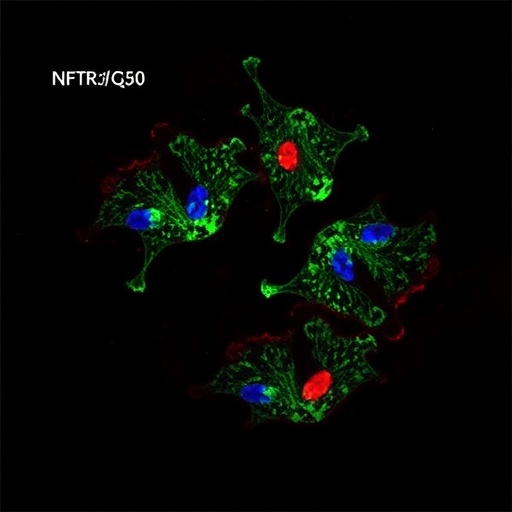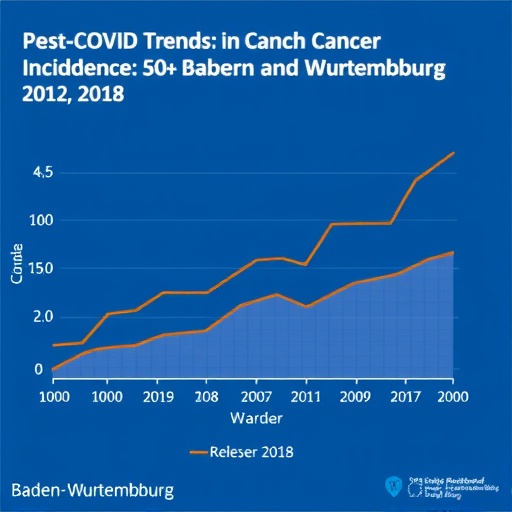Recent advances in cancer research have illuminated the profound complexities of tumor biology, especially within the realm of gliomas, a category of tumors arising from glial cells in the brain. Among the myriad factors that influence tumor progression and cellular proliferation, ubiquitin ligases have emerged as key players in regulating various cellular processes, including the cell cycle, apoptosis, and responses to stress signals. A recent study has brought to light the role of the E3 ubiquitin ligase BTRC in glioma cells, revealing its potential to inhibit tumor growth and facilitate therapeutic intervention. This research not only enhances our understanding of glioma biology but also opens new avenues for targeted therapies.
The study detailed in the timely publication by Li, Tang, and Jiang focuses on the mechanistic pathways through which the E3 ubiquitin ligase BTRC exerts its influence on glioma cell proliferation. Gliomas are notoriously aggressive, with a propensity for rapid growth and invasion, placing them amongst the deadliest forms of brain cancer. The discovery of molecular targets that can effectively curb this proliferation is paramount, and BTRC stands at the forefront of this investigative landscape. The researchers provide compelling evidence that BTRC operates as a significant negative regulator of glioma growth by modulating the NFAT5/AQP4 axis, a critical pathway known to be involved in the control of cellular water transport and osmoregulation.
The NFAT5 protein, a member of the nuclear factor of activated T cells family, is known for its essential role in the response to osmotic stress. In glioma cells, NFAT5 is involved in maintaining cellular homeostasis and mediating responses that may contribute to tumor cell survival. The interaction between NFAT5 and AQP4, which encodes a water channel protein, suggests that glioma cells could exploit this pathway to optimize their microenvironment for survival. In their findings, Li et al. demonstrate that the elevation of BTRC levels within glioma cells leads to the degradation of NFAT5, subsequently reducing AQP4 expression, thus impeding cellular proliferation.
These findings raise an intriguing question about the potential therapeutic implications of manipulating BTRC levels in gliomas. The precise modulation of the BTRC pathway could herald new innovative strategies for glioma treatment, particularly in cases where conventional therapies have proven insufficient. The dual role of BTRC, therefore, as a tumor suppressor and as a component of a new therapeutic approach, is an exciting focus for ongoing research in neuro-oncology.
Moreover, the study offers insight into the broader implications of ubiquitin ligases in cancer biology. The functional interactions facilitated by these enzymes uphold not only cellular structure and function but also influence the dynamics of tumor-host interactions. The proteolytic activities of E3 ligases like BTRC underlie a network of signaling pathways and could provide an array of potential targets for pharmacological intervention. The development of small molecules that could either enhance the activity of such ligases or mimic their action might lead to the creation of novel anti-cancer agents.
The discovery of BTRC’s role in suppressing glioma also aligns with emerging trends in cancer therapy that focus on precision medicine—tailoring treatment to the individual characteristics of the tumor being treated. By establishing the pivotal role of BTRC in glioma biology, researchers can begin to stratify patients based on their molecular profiles, potentially leading to more effective precision therapies that specifically target the underlying mechanisms of their tumors.
Advancements in genomic technologies have complemented studies like those by Li et al., offering deeper insights into the mutational landscape of gliomas. The advent of more sophisticated genetic screening techniques has enabled researchers to identify biomarkers associated with glioma progression and therapy response. Understanding genetic variants that influence both the expression levels of BTRC and its downstream targets can lead to better prognostic tools and predictive models for treatment outcomes.
The intricate world of glioma research is not without its challenges; glioma heterogeneity, for instance, poses significant obstacles in the quest for effective therapies. Different subtypes of glioma may respond variably to treatments aimed at the NFAT5/AQP4 axis, necessitating further studies to parse out the complexities of different tumor microenvironments. Understanding which patients will benefit most from BTRC modulation or related interventions will be essential in advancing the field.
In summary, the comprehensive investigation into the E3 ubiquitin ligase BTRC by Li, Tang, and Jiang unveils critical insights into glioma biology. By elucidating the relationship between BTRC, NFAT5, and AQP4, the researchers have not only delineated a new regulatory pathway but have also set the stage for innovative therapeutic strategies that could fundamentally alter the paradigms of glioma treatment. The fusion of molecular biology with therapeutic application embodies the ethos of modern cancer research, driving forward the mission to outsmart one of humanity’s most challenging adversaries.
As researchers continue to dissect the molecular intricacies of gliomas and the role of ubiquitin ligases, the hope remains that innovations borne from such studies will one day translate into enhanced patient outcomes and improved survival rates for those battling these aggressive tumors. Future efforts will ensure a concerted focus on translating the findings of research like this into actionable clinical strategies and improved therapies for glioma patients, with an emphasis on understanding the individual nature of these tumors.
Ultimately, the journey of discovery in understanding the implications of BTRC in glioma proliferation and growth is just beginning. Each study holds potential for revealing new targets, new pathways, and new hope for patients facing the adversity that gliomas represent. The rigorous scientific inquiry into E3 ubiquitin ligases, specifically BTRC, embodies the spirit of relentless pursuit in cancer research—a quest unceasing in its urgency and commitment to unveil the mysteries of cancer and to deliver effective solutions.
Subject of Research: The role of E3 ubiquitin ligase BTRC in glioma cell proliferation and tumor growth.
Article Title: E3 ubiquitin ligase BTRC inhibits the proliferation and tumor growth of glioma cells through the NFAT5/AQP4 axis.
Article References:
Li, Y., Tang, S., Jiang, K. et al. E3 ubiquitin ligase BTRC inhibits the proliferation and tumor growth of glioma cells through the NFAT5/AQP4 axis.
J Cancer Res Clin Oncol 151, 301 (2025). https://doi.org/10.1007/s00432-025-06346-z
Image Credits: AI Generated
DOI:
Keywords: Glioma, E3 ubiquitin ligase, BTRC, NFAT5, AQP4, cancer biology, tumor growth, targeted therapy, precision medicine.
Tags: brain cancer treatment optionsBTRC E3 ubiquitin ligasecancer research advancesglial cell tumorsglioma cell proliferationglioma tumor biologymechanisms of glioma progressionmolecular targets in cancernegative regulators of tumor growthNFAT5 AQP4 pathwaytargeted therapies for gliomatherapeutic intervention in gliomas





